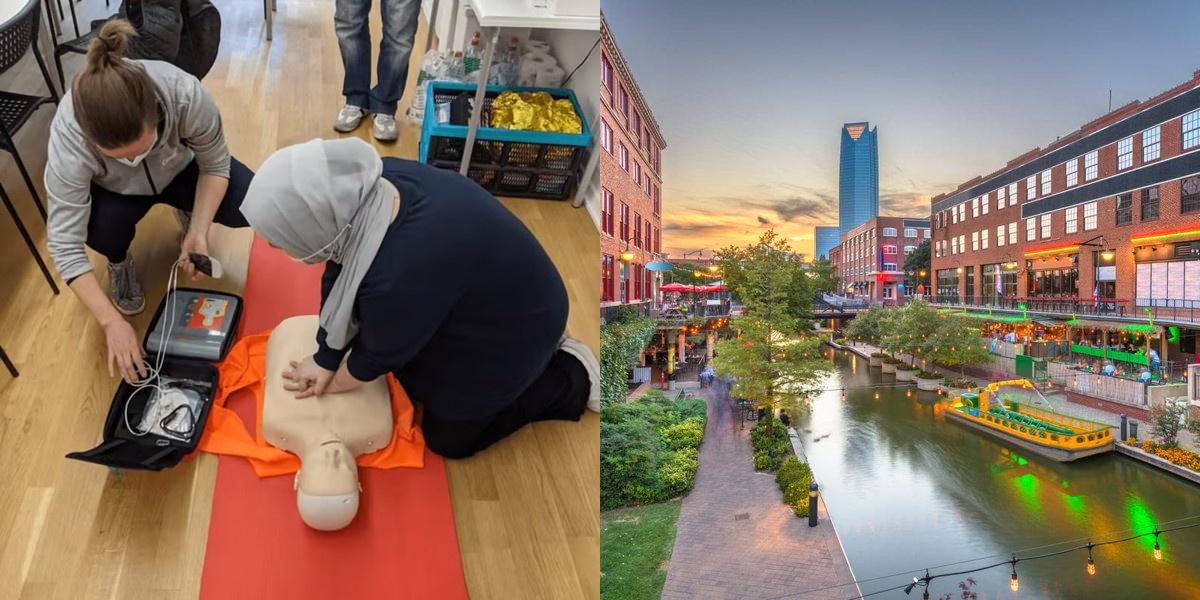What is a Paramedic?
A paramedic is a highly trained medical professional who provides emergency medical care to individuals in need. They are often the first responders in emergency situations and play a crucial role in saving lives. Paramedics are trained to assess a patient's condition, provide on-site medical treatment, administer medications, and transport patients to medical facilities.
Where does a Paramedic work?
Paramedics can work in a variety of settings, including ambulance services, hospitals, fire departments, and other emergency medical service organizations. They may also be employed in industrial settings, providing medical care to workers.
How to Become a Paramedic in Oklahoma?
To become a Paramedic in Oklahoma, one must first complete an accredited Paramedic education program, typically a 1-2 year Associate's degree. Next, obtain Paramedic certification by passing the National Registry of Emergency Medical Technicians (NREMT) exam. Once certified, individuals can search for Paramedic job opportunities to start earning a competitive salary.
What are the requirements to become a Paramedic in Oklahoma?
To become a paramedic in Oklahoma, you must meet certain education and legal requirements. These include:
- High School Diploma or GED: You must have a high school diploma or equivalent to pursue a career as a paramedic.
- EMT-Basic Certification: Before becoming a paramedic, you must first obtain certification as an Emergency Medical Technician (EMT)-Basic. This certification can be obtained through an accredited training program.
- Paramedic Training: After completing EMT-Basic certification, you must complete a paramedic training program. These programs are typically offered by community colleges or vocational schools and can take anywhere from 6 months to 2 years to complete.
- National Registry Exam: Once you have completed your paramedic training, you must pass the National Registry Exam to become a certified paramedic in Oklahoma.
- State Licensure: In addition to national certification, you must also obtain a state license to practice as a paramedic in Oklahoma. This typically involves submitting an application, providing proof of education and certification, and paying a fee.
Exploring a Career in Paramedic Outside Oklahoma
If you've been reading this article and aspire to become a Paramedic, but you reside in a different state, rest assured that achieving your goal is still within reach. You might consider exploring opportunities to become a Paramedic in Hawaii, Maine, Nebraska, Virginia, or West Virginia. Don't worry if you haven't found your location among these, because Dreambound makes it easier than ever to pursue your dreams regardless of your location by simplifying the process of finding and comparing CPR-BLS classes through a convenient search by zip code. With dedication and access to the right resources, you can confidently pursue a successful career in healthcare, no matter where you live.
How do I get my Paramedic certification?
Becoming a paramedic is an excellent career choice for those who are passionate about helping others and want to make a difference in their community. Paramedics are healthcare professionals who provide emergency medical services to individuals in need. They are trained to assess patients, provide medical treatment, and transport them to the hospital if necessary.
If you are interested in pursuing a career as a paramedic, there are a few steps you need to take to obtain your certification. Here is a step-by-step guide on how to become a certified paramedic:
1. Research the requirements: The first step in obtaining your paramedic certification is to research the requirements in your state or country. Each jurisdiction may have different requirements, so it's important to understand what is needed in your area. In the United States, paramedics are certified at the state level, and requirements can vary from state to state.
2. Complete the prerequisites: Once you have a clear understanding of the requirements, you will need to complete any necessary prerequisites. This may include obtaining a high school diploma or GED, completing a basic EMT course, and gaining some experience in the field.
3. Enroll in a paramedic program: After completing the prerequisites, you will need to enroll in a paramedic program. These programs are typically offered by community colleges or technical schools and can vary in length from one to two years. During the program, you will learn advanced medical skills, such as administering medications, performing advanced airway management, and interpreting electrocardiograms (EKGs).
4. Complete clinical rotations: In addition to classroom instruction, paramedic programs also require students to complete a certain number of clinical rotations. These rotations allow students to gain hands-on experience in a variety of settings, such as emergency departments, ambulances, and intensive care units. This is a crucial part of the training process, as it allows students to apply what they have learned in a real-world setting.
5. Take the national certification exam: After completing your paramedic program and clinical rotations, you will need to take the National Registry of Emergency Medical Technicians (NREMT) exam. This exam is a requirement for certification in most states and consists of both a written and practical component. The written portion of the exam tests your knowledge of paramedic skills and medical concepts, while the practical portion assesses your ability to perform various skills in a simulated setting.
6. Apply for state certification: Once you have successfully passed the NREMT exam, you can apply for state certification. The process may vary depending on your state but typically involves submitting an application, paying a fee, and providing proof of your education and exam results. Once you receive your state certification, you can legally work as a paramedic in your jurisdiction.
It's important to note that paramedic certification is not a one-time event. In order to maintain your certification, you will need to complete continuing education requirements and periodically renew your certification. This ensures that paramedics stay up-to-date on the latest medical advancements and continue to provide quality care to their patients.
How do I get a job as a Paramedic?
Once you have obtained your paramedic certification, the next step is to find a job in the field. Here are a few tips to help you get started:
1. Network to expand your reach: Networking is key to finding job opportunities in the paramedic field. Reach out to your instructors, classmates, and others in the industry you've met during your training. Attend industry events and join professional organizations to broaden your connections. Often, networking can lead to insights about job openings that aren't publicly advertised.
2. Craft a compelling resume and cover letter: Your resume and cover letter are your first impression on potential employers. Highlight your relevant skills, certifications, and any specialized training. Tailor your resume to each job application, emphasizing experiences that match the specific role you're applying for. Include volunteer work and extracurricular activities that demonstrate your commitment to healthcare and emergency services.
3. Apply strategically to job openings: Search for paramedic job postings on online job boards, hospital websites, and local government portals. Contact local ambulance services, fire departments, and healthcare facilities directly to inquire about openings. Be prepared to complete applications, provide references, and undergo background checks and drug screenings as part of the hiring process.
4. Prepare thoroughly for interviews: If selected for an interview, thorough preparation is essential. Research the organization beforehand to understand its mission, values, and services. Practice answering common interview questions that assess your clinical skills, decision-making abilities, and commitment to patient care. Dress professionally, arrive punctually, and demonstrate enthusiasm for the opportunity to contribute to the team.
5. Consider volunteering or part-time work: If full-time paramedic positions are limited, consider gaining experience through volunteer work or part-time roles in healthcare or emergency services. Volunteering not only builds your resume but also allows you to demonstrate your dedication and gain practical skills that could lead to future employment opportunities. Many organizations prefer hiring individuals who have demonstrated commitment and competence through volunteer or entry-level roles.
Career Paths and Opportunities after Becoming a Paramedic
Once you have become a certified paramedic, there are a variety of career paths and opportunities you can explore. Here are a few options to consider:
-
Emergency Medical Services (EMS): Many paramedics work for EMS agencies, responding to emergency calls and providing medical treatment to patients in need. EMS agencies can range from small, local services to larger, regional organizations. Working in EMS allows paramedics to gain a wide range of experience and work in a fast-paced, dynamic environment.
-
Hospital Emergency Departments: Some paramedics choose to work in hospital emergency departments. In this role, paramedics may work alongside nurses and physicians to provide initial assessments and interventions for patients who arrive by ambulance. Working in a hospital setting can provide additional opportunities for learning and advancement, as well as exposure to a variety of medical conditions.
-
Flight Paramedics: Flight paramedics are specially trained to provide medical care in air transport settings. They work on helicopters and fixed-wing aircraft, transporting critically ill or injured patients from the scene of an accident to a hospital or between medical facilities. This role requires additional training and certification but can be rewarding for those who enjoy the challenge of working in high-pressure situations.
-
Fire Departments: Many fire departments employ paramedics as part of their emergency response teams. These paramedics work alongside firefighters, responding to a variety of emergency situations, including fires, accidents, and medical emergencies. Working for a fire department can provide the opportunity to serve the community in multiple ways and may offer additional benefits and job security.
-
Teaching and Education: Experienced paramedics may choose to pursue a career in teaching or education. This can involve teaching paramedic students in a classroom or clinical setting, as well as providing continuing education courses to practicing paramedics. Teaching can be a rewarding way to share your knowledge and experience with others and help shape the next generation of paramedics.
-
Management and Administration: Some paramedics choose to move into management or administrative roles within the healthcare industry. This may involve overseeing a team of paramedics, managing a department or organization, or working in a regulatory or policy setting. These roles often require additional education or experience but can offer opportunities for advancement and increased responsibility.





